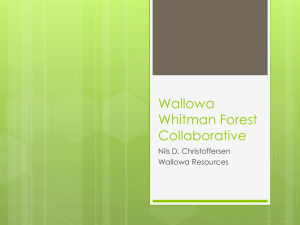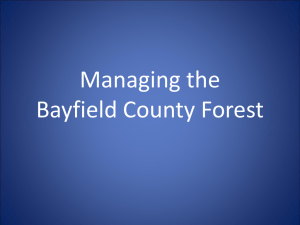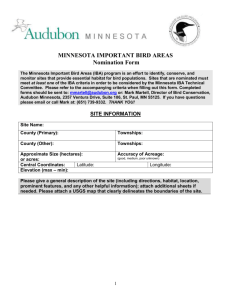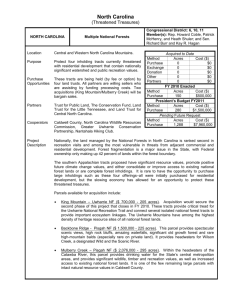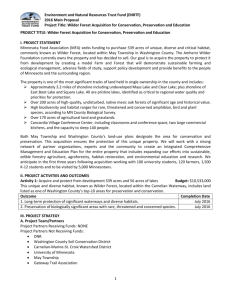MA 5 Cassidy Creek Management Area 8-1-13
advertisement
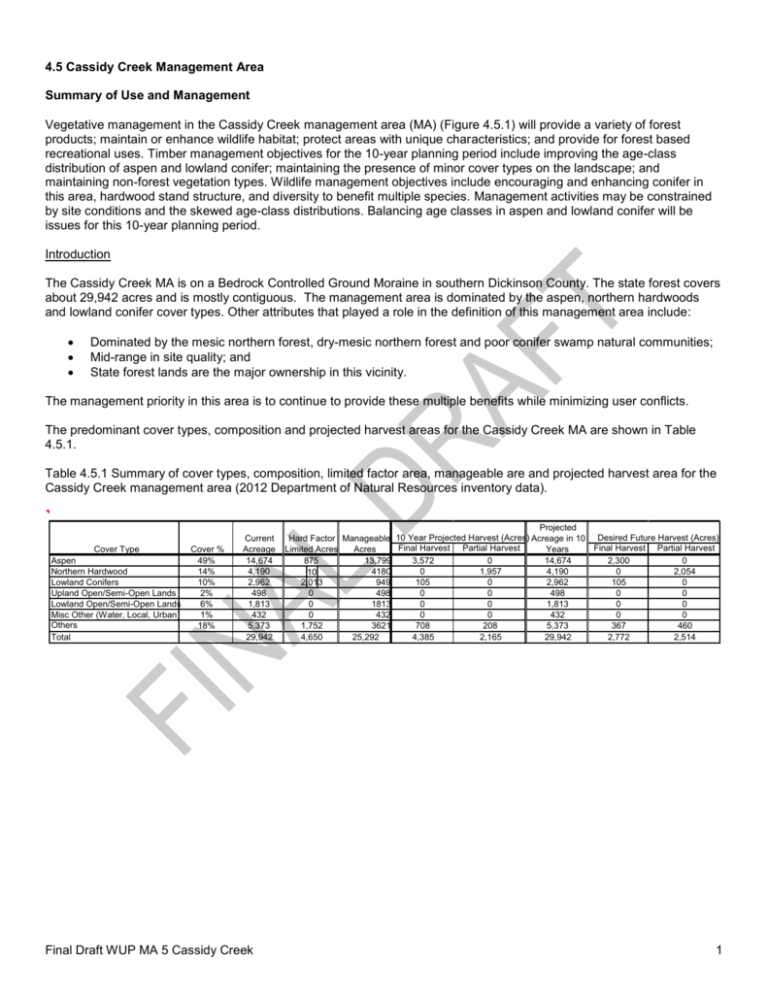
4.5 Cassidy Creek Management Area Summary of Use and Management Vegetative management in the Cassidy Creek management area (MA) (Figure 4.5.1) will provide a variety of forest products; maintain or enhance wildlife habitat; protect areas with unique characteristics; and provide for forest based recreational uses. Timber management objectives for the 10-year planning period include improving the age-class distribution of aspen and lowland conifer; maintaining the presence of minor cover types on the landscape; and maintaining non-forest vegetation types. Wildlife management objectives include encouraging and enhancing conifer in this area, hardwood stand structure, and diversity to benefit multiple species. Management activities may be constrained by site conditions and the skewed age-class distributions. Balancing age classes in aspen and lowland conifer will be issues for this 10-year planning period. Introduction The Cassidy Creek MA is on a Bedrock Controlled Ground Moraine in southern Dickinson County. The state forest covers about 29,942 acres and is mostly contiguous. The management area is dominated by the aspen, northern hardwoods and lowland conifer cover types. Other attributes that played a role in the definition of this management area include: Dominated by the mesic northern forest, dry-mesic northern forest and poor conifer swamp natural communities; Mid-range in site quality; and State forest lands are the major ownership in this vicinity. The management priority in this area is to continue to provide these multiple benefits while minimizing user conflicts. The predominant cover types, composition and projected harvest areas for the Cassidy Creek MA are shown in Table 4.5.1. Table 4.5.1 Summary of cover types, composition, limited factor area, manageable are and projected harvest area for the Cassidy Creek management area (2012 Department of Natural Resources inventory data). Cover Type Aspen Type Northern Hardwood n Lowland Conifers Hardwood Upland Open/Semi-Open Lands Conifers Lowland Open/Semi-Open Lands Lands Misc Other (Water, Local, Urban) Lands Others Urban) Total s l Cover % 49% %14% % 10% % 2% % 6% % 1% % 18% % % Current Acreage t14,674 e 4,190 42,962 0498 2 1,813 8 432 3 5,373 2 29,942 3 2 Final Draft WUP MA 5 Cassidy Creek Projected Hard Factor Manageable 10 Year Projected Harvest (Acres) Acreage in 10 Desired Future Harvest (Acres) d Years Final Harvest Partial Harvest Final Harvest Partial Harvest Limited Acres Acres (Acres) Factor e 10 14,674 875 13,799 (Acres) 3,572 0 2,300 0 Harvest Harvest Harvest Acres10 s s4,190 0 0 4180 Harvest 1,957 2,054 5 9 949 2105 42,962 0105 0 0 2,013 0498 70 0498 40 00 0 0 30 9 50 2 50 0 0 1813 1,813 8 8 0 432 0 0 432 0 0 3 3 1,752 3621 708 208 5,373 367 460 2 4,650 25,2922 4,385 2,165 29,942 2,772 2,514 2 1 8 8 3 7 0 0 2 5 5 2 2 4 1 Figure 4.5.1. A map of the Cassidy Creek management area (dark green boundary) in relation to surrounding state forest and other lands in Dickinson County, Michigan. 4.5.1 Forest Cover Type Management Direction The following sections contain information on vegetation management for each of the major cover types, a grouping of minor cover types and important non-forested vegetation types for the Cassidy Creek management area in the form of Desired Future Condition, 10-Year Management Objectives and Long-Term Management Objectives. This information applies to those portions of the forest where active management (i.e., timber harvest, prescribed fire, planting or mowing) will be conducted. In other portions of the state forest, the natural processes of succession and disturbance will provide ecological benefits. While most stands have a variety of tree species and other vegetation, they are classified by the species with dominant canopy coverage. Final Draft WUP MA 5 Cassidy Creek 2 The following cover types are valued commercially for their timber products; ecologically as sources of habitat for numerous wildlife species; and for the variety of recreational opportunities they provide. Harvesting and regenerating these cover types will provide for a continuous flow of forest products and will help to ensure (or provide) wildlife habitat. Aspen Cover Type Current Condition About 14,674 acres (49%) of state forest land in this management area are in the aspen cover type (Table 4.5.1). Most of the upland cover types in this management area are found on medium-productive sites. Aspen is poorly distributed across age classes spiking in the 20-29 year age class (Figure 4.5.2). There are 875 acres of aspen that have harvest limitations at this time. These hard factor limited acres have been removed from the total number of manageable acres available for harvest calculations. Figure 4.5.2 Graph of the age-class distribution for the aspen cover type on the Cassidy Creek management area (2012 Department of Natural Resources inventory data). Desired Future Condition Balanced acres in each age class over a 50-year rotation; Provide an even supply of forest products; Provide a balanced mix of habitat conditions for a variety of wildlife; and Provide a variety of hunting-type opportunities. Long-Term Management Objectives Harvest and regenerate approximately 2,300 acres each decade, based on a 50 year rotation; and Stands of aspen with harvest limitations will succeed to more shade tolerant species. 10-Year Management Objectives Over the next 10 years, 3,572 acres should be harvested to balance age classes; and Two-aged stands with mature aspen over younger stands should be identified and scheduled for harvest Northern Hardwood Cover Type Current Condition Northern hardwood stands make up 4,190 acres (14%) of state forest land in this management area (Table 4.5.1). They occur on high-quality sugar maple sites. Most stands have been managed on a selection harvest basis, but have had Final Draft WUP MA 5 Cassidy Creek 3 limited regeneration success. Many stands have a well-established sedge understory with little tree regeneration, shrub or herbaceous plant communities. Northern hardwood is typically managed using an uneven-aged harvest system based on basal area rather than age. Figure 4.5.3 shows the current basal area distribution for the management area, and also indicates that a small number of acres were recently harvested under an even-aged system, shown as immature. Figure 4.5.3. Graph of the basal area distribution for the northern hardwood cover type on the Cassidy Creek management area (2012 Department of Natural Resources inventory data). Desired Future Condition Uneven-aged northern hardwood stand structure promoting high-value sugar maple sawlogs with a full complement of tree seedlings recruiting into the overstory, well developed shrub and herbaceous layers Long-Term Management Objectives Using an uneven-aged system, selectively harvest northern hardwood stands on a 20-year cycle (this will result in an estimated 2,054 acres harvested each decade); and Work to increase hardwood regeneration and reduce the sedge component. 10-Year Management Objectives Approximately 1,957 acres will be selectively cut in the next decade (this is slightly lower than the expected regulated amount due to the current basal area structure); Maintain white pine, hemlock, oak and upland cedar where they occur in stands that are cut; and Experiment with mechanical and chemical treatments of the sedge understory to establish northern hardwood tree regeneration and improve understory diversity. Lowland Conifers Cover Type Current Condition Lowland conifers occur on 2,962 acres (10%) of the management area (Table 4.5.1). Lowland conifers are found on poorly drained sites supporting mixed stands of cedar, black spruce, tamarack, balsam fir, white birch and balsam poplar. Currently, there are 2,013 acres of lowland conifer stands that have factor limits due to wet conditions or for riparian corridors. These hard factor limited acres have been removed from the total number of manageable acres available for harvest calculations. Due to the wet site conditions, they are more susceptible to rutting damage from logging equipment and present difficult operating conditions for harvesting. Lowland conifers are poorly distributed across the age classes. Most of the stands are between 70 and 120 years old (Figure 4.5.4). Final Draft WUP MA 5 Cassidy Creek 4 Figure 4.5.4. Graph of the age-class distribution for the lowland conifer cover type on the Cassidy Creek management area (2012 Department of Natural Resources inventory data). Desired Future Condition Closed canopy stands interspersed with patches of all age classes; Sustainable regeneration and recruitment of seedlings and saplings; Maintain the closed canopy structure to provide important winter deer habitat; and Plan to harvest the oldest available stands to regenerate them before widespread mortality occurs. Long-Term Management Objectives Manage stands on an 80-year rotation allowing for approximately 105 acres to be harvested per decade; Regenerate stands to species mixes similar to the pre-harvest conditions preferring cedar, hemlock, black spruce and balsam fir; Harvesting will be done using small clearcuts or strips with clumped retention; and Lowland conifer stands with harvest limitations will be subject to natural processes, resulting in a range of successional stages. 10-Year Management Objectives Harvest about 105 acres over the next decade focusing on the use of “low impact” harvesting systems and successful, reliable regeneration techniques; and Monitor harvested sites to assure adequate regeneration. Other Forested Cover Types Current Condition Other forested types make up 5,373 acres and are made up of cedar (1,174 acres), lowland deciduous (914 acres), upland spruce/fir (710 acres), red pine (640 acres), paper birch (256 acres), lowland mixed forest (247 acres), lowland spruce/fir (236 acres), lowland poplar (190 acres), mixed upland deciduous (173 acres), tamarack (172 acres), mixed upland deciduous (164 acres), natural mixed pine (163 acres), white pine (152 acres), upland conifers (134 acres), upland mixed forest (114 acres), oak (74 acres), jack pine (18 acres), and hemlock (15 acres). Together these types make up about 18% of the management area (Table 4.5.1). Approximately 1,752 acres of these other minor cover types have site conditions limiting their harvest this decade. These hard factor limited acres have been removed from the total number of manageable acres available for harvest calculations. Final Draft WUP MA 5 Cassidy Creek 5 Desired Future Condition Maintain the presence of the minor cover types within the management area. Long-Term Management Objectives Manage minor cover types to maintain representation using appropriate silvicultural methods; Monitor to assure adequate regeneration of desired species; Featured species habitat requirements will be taken in to consideration; Maintain hemlock as it occurs; and Where stands have site conditions limiting harvest, early successional cover types will be lost through natural succession. 10-Year Management Objectives Harvest those stands without harvest limitations adjacent to other planned harvest activities and where stand and habitat conditions indicate that harvesting is appropriate; and Projected harvests in these cover types include 708 acres of final harvest, and 208 acres of partial harvest over the next decade. Other Non-forested Cover Types Current Condition Non-forested cover types found on this management area include: upland open/semi-open lands (498 acres – 2%), lowland open/semi-open lands (1,813 acres – 6%), and other (water, local, urban) (432 acres – 1%) (Table 4.5.1). Desired Future Condition These areas will be maintained in the current condition. Long-Term Management Objective Grass will be burned or mowed to prevent forest encroachment. 10-Year Management Objective Grass-types will be treated for opening maintenance as needed. 4.5.2 – Featured Wildlife Species Management The Cassidy Creek management area contains numerous rocky outcrops and areas with thinner soils that should be moved into later successional and conifer species, where appropriate. Conifer should be encouraged and enhanced in this area. Hardwood stands should be managed for structure and diversity to benefit multiple species. The primary focus of wildlife habitat management in the Cassidy Creek management area will be to address the habitat requirements identified for the following featured species: American woodcock, blackburnian warbler, northern goshawk, white-tailed deer and wood duck. Some of the most significant wildlife management issues in the management area are early successional forest conditions (associated with alder, riparian zones, or forested wetlands); mesic conifers; mature forest (upland and adjacent to water); habitat fragmentation; coarse woody debris, white-tailed deer wintering habitat; and hard mast. During this 10-year planning period, additional analyses to better define the spatial extent of priority areas (e.g. lowland and riparian habitat with potential for early successional woodcock habitat management) for featured species will be performed. American Woodcock The western Upper Peninsula (WUP) goal for woodcock is to maintain or increase woodcock habitat. In priority areas, management should focus on balancing the age-class distribution and provision of display, feeding, nesting and broodrearing habitat via upland brush, opening and poorly stocked stand management. Final Draft WUP MA 5 Cassidy Creek 6 Wildlife habitat specifications: Maintain aspen cover types within the management area, especially where associated with alder, riparian zones, or forested wetlands; Balance aspen age-class distribution within the management area; Use silvicultural practices that encourage the aspen component in mixed stands associated with alder, riparian zones or forested wetlands; and Maintain or create rough openings associated with alder, riparian zones, regenerating aspen or forested wetlands within the management area. Blackburnian Warbler The goal for blackburnian warbler is to maintain suitable breeding habitat. Management efforts for blackburnian warblers should focus on within stand diversity, discouraging habitat fragmentation and maintaining mature forest with a conifer component in priority landscapes. Specifically, increase mesic conifer cover types (i.e., hemlock, white pine, red pine, upland spruce-fir) and allow some to mature beyond standard rotation ages, retain a larger percentage of mesic conifer during harvests, employ silvicultural practices that encourage the regeneration of mesic conifers and where feasible, under plant hemlock, white pine and white spruce in hardwood-dominated stands. Wildlife habitat specifications: Increase the mesic conifer (e.g., hemlock, white pine, natural red pine and upland spruce-fir) component on state forests by: a) Retaining a larger percentage of mesic conifer during harvests; b) Using silvicultural practices that encourage the regeneration of mesic conifer; and c) Where desired/feasible, under plant hemlock, white pine and white spruce in hardwood-dominated stands on suitable sites without a seed source. Provide for late successional mesic conifer-dominated, particularly hemlock, stands in the management area by extending the normal rotation length for white spruce and balsam fir cover types by 20 years in upland areas. Northern Goshawk The goal for northern goshawk is to maintain suitable habitat. Management at the stand scale should focus on the protection of nest trees, provision of coarse woody debris and on addressing fragmentation. Landscape scale management should provide mature and old aspen stands in the 60-69 year-old age class. Wildlife habitat specifications: Maintain a minimum of 15% of the state forest aspen resource above age of 60 in this management area (this can be accomplished using factor limited stands, special resource areas, etc…). All known woodland raptor nests should be reported to local wildlife staff and documented in the Integrated Forest Monitoring Assessment and Prescription (IFMAP) comments. If the species is known, the common name should be included in those comments. For northern goshawk nests, the wildlife habitat specifications contained within Michigan DNR’s Interim Management Guidance for RedShouldered Hawks and Northern Goshawk on State Forest lands (August 2012) will be followed until the workgroup has completed the guidance that will permanently replace the interim guidelines. White-tailed Deer The WUP goals for white-tailed deer are to: 1) Maintain existing deer wintering complexes, and 2) Expand the extent of areas suitable as winter deer habitat, especially in the medium and high snowfall zones. Management should focus on maintaining habitat quality in priority wintering complexes. DNR department procedure 32.22-07 states “Coniferous swamps are important as winter deeryards and shall be managed primarily for deer. The objective shall be to maintain them for this purpose and through commercial cuttings and silvicultural practices, improve these areas to provide winter cover and food for deer.” There is a complex relationship between deer abundance, available summer and winter habitat, timber management, and regeneration tree species, particularly white cedar and hemlock. It is recognized that meeting both timber management and deer goals presents challenges for the department and our stakeholders. Information on deer wintering complexes is currently being updated and new management guidelines are being developed. When completed, these will provide additional direction for managing these critical areas for white-tailed deer. Final Draft WUP MA 5 Cassidy Creek 7 Wildlife habitat specifications for deer wintering complexes: 1. Strive to maintain > 50% of the land area within deer wintering complexes in mixed or pure stands of cedar, hemlock, white and black spruce, white and natural red pine, balsam fir, mixed swamp conifer and mixed upland conifer-hardwood. 2. In northern white cedar and hemlock cover types that are commonly occupied by deer during severe winters, especially in medium and high snowfall zones, maintain canopy closure of >65%. 3. In deer wintering complexes in low snowfall areas, and within ¼ mile of severe-winter cover in the higher snowfall zones, write prescriptions that strive to maintain canopy closure of 40-65%, favoring cedar, hemlock, white spruce, black spruce, balsam fir and white pine. 4. Provide winter forage in deer wintering complexes through stands of regenerating hardwood or brush, including preferred species of red maple, sugar maple, aspen, yellow birch, ashes, oaks, dogwood, crabapple, elderberry, high-bush cranberry, sumac and hazel. 5. Enhance accessibility to winter browse within deer wintering complexes by maintaining mature mesic conifer components within upland hardwood stands or by maintaining or enhancing sheltered travel corridors between areas of conifer cover and browse. 6. Provide spring break out areas by maintaining open hardwood stands on southern exposures and herbaceous openings adjacent to deer wintering complexes. 7. When possible, timber harvests within deer wintering complexes should be carried out only during winter months and tops should be left. Chipping of non-bole wood and whole-tree harvesting in the deer wintering complexes should be avoided, but will be discussed on a case-by-case basis through the compartment review process. 8. Harvests of cedar and hemlock may only be conducted when: a. There is reasonable confidence of successful recruitment/regeneration of the cover types; or b. There is a forest health issue (e.g. hemlock wooly adelgid); or c. Part of an approved research project; or d. Removal of selected trees will facilitate a reduction of harvest trails, landings, etc. to minimize soil sedimentation and possible soil compaction issues. 9. Provide fall foods in the form of hard and soft mast, and provide dense escape cover or bedding areas in the form of early successional forests, brush, and warm-season grasses that will encourage fall deer use in areas open to public hunting. Where habitat types are appropriate, increase diversity of hard mast by planting oak. Wood Duck The WUP goal for wood duck is to maintain or increase suitable habitat. Management should focus on the protection of forest wetland, riparian corridors, providing large cavity trees, mast and the management of priority wildlife management areas with suitable habitat. Wildlife habitat specifications: In landscapes that contain streams, beaver ponds and other potential habitat for wood ducks, provide potential nesting sites by providing mature forest (possibly special conservation area designations) and/or big-tree silviculture near water. Retain all large diameter over-mature cavity trees within 300 feet of water bodies for cavities in lowland and upland hardwoods. Where adjacent forest is young or cavities limited, nest trees should be promoted. Where appropriate, manage for mast in riparian areas Increase potential riparian buffers to 300+ feet, where desired, instead of the standard 100 foot best management practice. 4.5.3 – Rare Species and Special Resource Area Management All forest operations must be reviewed for potential conflicts between rare species and proposed forest operations following the guidance in “DNR’s Approach to the Protection of Rare Species on State Forest Lands” (IC4172). This is especially important when listed species are present, when past surveys have indicated a possibility of their presence, or when appropriate habitat is available and the species is known to occur in the general region. Past surveys have noted and confirmed nine listed species and no natural communities of note occurring in the management area as listed in Table 4.5.2. Elk has also been noted in the management area but is not a listed species by MNFI standards. Any established management guidelines will be followed. Further surveys for special species and natural communities will be carried out as a matter of course during the inventory process and opportunistically for special more focused surveys. Final Draft WUP MA 5 Cassidy Creek 8 The Bloomgren’s Marsh and Hancock Creek Flooding State Wildlife Management Areas are special conservation areas within this management area as shown in Figure 4.5.5. Approximately 24.5 acres of potential old growth have been identified within the Cassidy Creek management area. These stands were identified for a broad range of reasons and were coded in the Operations Inventory database as Stand Condition 8. These stands area also special conservation areas until they are evaluated. There have been no high conservation value areas or ecological reference areas identified in the management area. Management goals during this planning period: Goal 1: To develop and maintain a list of rare, threatened, endangered and special concern species and natural communities for the management area through a continuous inventory and through opportunistic focused inventory surveys. Objective 1-1: Field staff should be trained and aware of the identification characteristics and natural history of rare, threatened, endangered and special concern species. Objective 1-2: Occurrences of rare, threatened, endangered and special concern species noted during the inventory process by inventory staff should be verified and added to the body of knowledge for the management area. Goal 2: To evaluate the potential old growth areas by the end of this 10-year planning period. Table 4.5.2. Occurrence information for special concern, rare, threatened and endangered communities and species for the Cassidy Creek management area. Common Name Scientific Name Status Status in Climate Change Confidence Management Vulnerability Area Index (CCVI) Birds Common loon Gavia immer T/G5/S3-4 Confirmed HV Very High Bald eagle Haliaeetus leucocephalus SC/G5/S4 Confirmed IL Moderate Osprey Pandion haliaetus SC/G5/S2-3 Confirmed PS Low Mullusks Slippershell mussel Alasmidonta viridis T/G4G5/S2S3 Confirmed EV Very High Black sandshell Round pigtoe Ligumia recta Pleurobema sintoxia E/G5/SNR Confirmed SC/G4G5/S2S3 Confirmed ? HV ? Low Reptile Wood turtle Glyptemys insculpta SC/G4/S2S3 Confirmed MV Moderate Plants Goblin moonwort Botrychium mormo T/G3/S2 Confirmed Blunt-lobbed woodsia Woodsia obtusa T/G5/S1S2 Confirmed Natural Community Association Probable Cover Types Successional Stage Emergent Marsh Bog Bog Hardwood-conifer swamp Northern hardwood swamp Poor conifer swamp Floodplain forest Dry northern forest Dry-mesic northern forest Mesic northern Forest Coastal fen Northern hardwood swamp Floodplain forest Hardwood-conifer swamp Lowland open/semi-open Lowland open/semi-open Lowland open/semi-open Lowland Mixed Black Ash Tamarack Lowland mixed Jack Pine, Red Pine White Pine Northern Hardwood Lowland open/semi-open Black Ash Lowland Mixed Lowland Mixed N/A N/A N/A Mid Late Late Mid Early Late Late N/A Late Mid Mid Headwater Stream Mainstem streams Inland lake Unknown Mainstem streams Rivers Aquatic Aquatic Aquatic N/A N/A N/A Aquatic Aquatic N/A N/A Northern wet meadow Bog Rich conifer swamp Hardwood-conifer swamp Northern shrub thicket Mesic northern forest Lowland open/semi-open Lowland open/semi-open Tamarack Lowland Mixed Upland open/semi-open Northern Hardwood N/A N/A Late Mid N/A Late Mesic northern forest Boreal forest Volcanic bedrock lakeshore Volcanic cliff Limestone cliff Limestone bedrock glade Granite bedrock glade Granite cliff Northern Hardwood Upland & Lowland Sp/F Upland open/semi-open Upland open/semi-open Upland open/semi-open Upland open/semi-open Upland open/semi-open Upland open/semi-open Late Mid N/A N/A N/A N/A N/A N/A Climate Change Vulnerability Index: EV – Extremely Vulnerable; HV – Highly Vulnerable; MV – Moderately Vulnerable; PS – Presumed Stable; and IL – Increase Likely. Final Draft WUP MA 5 Cassidy Creek 9 4.5.4 – Forest Health Management Although forest health issues span the entire landscape, some specific threats are more important in this management area due to the species composition, site quality or other factors. Some of the more important forest health pests in this area include: White trunk rot of aspen; Hypoxylon canker; Emerald ash borer; and Spruce budworm. When forest pests are detected, they are to be reported to the forest health specialist for treatment recommendations. The treatment of large outbreaks of forest pests will be coordinated on a state and regional level Several invasive exotic species of plants are thought to be located in the vicinity. When invasive species are detected, they will be reported to the forest health specialist and treatment options will be reviewed. Priority for treatment should be given to those species that threaten sensitive sites due to their location or growth characteristics and have population levels that may be successfully controlled. Following is a list of species of concern that been documented in or near this management area: Common buckthorn; Garlic mustard; Glossy buckthorn; Japanese knotweed; and Phragmites. Final Draft WUP MA 5 Cassidy Creek 10 Figure 4.5.5. A map of the Cassidy Creek management area showing the special resource areas. 4.5.5 – Aquatic Resource Management Fisheries Division management unit biologists will review proposed forest management activities using the compartment review process, and will consider the potential impact of proposed prescriptions upon riparian and aquatic values. Management prescriptions will be modified to account for riparian and aquatic values by applying the standards and guidance documents listed in the introduction to this plan section to the unique conditions specific to any given forest stand. Prescription of riparian management zone widths greater than the minimum widths provided in IC4011 must be justified and documented during the compartment review process. Final Draft WUP MA 5 Cassidy Creek 11 Forested stands adjacent to designated high priority trout streams will specifically be managed to discourage beaver use in accordance with both DNR Policy and Procedure 39.21-20 Beaver Management and IC 4011. Designated high priority trout streams are identified in the IFMAP Geographic Decision Support Environment. Remove or discourage beaver populations on designated high priority trout streams. High priority trout streams in this management area are shown in Figure 4.5.1. 4.5.6 – Fire Management Much of the area is covered by mesic and lowland forest communities. Fire return interval was generally very long. However, significant portions of the management area probably supported dry-mesic pine forests with shorter fire intervals. All wildfires are subject to appropriate initial attack suppression response The Norway Off-Road Vehicle (ORV) trailhead off Holmes Road on the east end presents an opportunity for fire prevention messages about spark arrestors. Work to develop modified suppression strategies for portions of this area 4.5.7 – Public Access and Recreation This area has good public and management access. Roads are primarily gravel or poor dirt roads. The Norway Off-Road Vehicle (ORV) Trail, snowmobile trail and portions of the Merriman Ski Trail are located in this area. Both the ORV and the ski trails are heavily used by the public. There are no state forest campgrounds in this management area. The department will continue to maintain the public access to this area. Work to improve the quality of the road system as opportunities arise. 4.5.8 – Oil, Gas and Mineral Resources Exploration and development for oil and gas has been limited to a few wells drilled in the eastern Upper Peninsula and no economic oil and gas production has been found anywhere in the Upper Peninsula. Surface sediments consist of mostly thin to discontinuous glacial till over bedrock with some glacial outwash sand and gravel and postglacial alluvium and medium-textured till. There is insufficient data to determine the glacial drift thickness. Sand and gravel pits are located in the vicinity of the management area and there may be some potential. The Precambrian Archean Granite/Gneiss, Michigamme and Chocolay Formations, and the Cambrian Munising Group subcrop below the glacial drift. Some of the Granite/Gneiss could be used as dimension stone. Old iron mines are located to the southwest of the management area. Metallic mineral exploration has occurred in this area in the past and there could be potential. Final Draft WUP MA 5 Cassidy Creek 12

